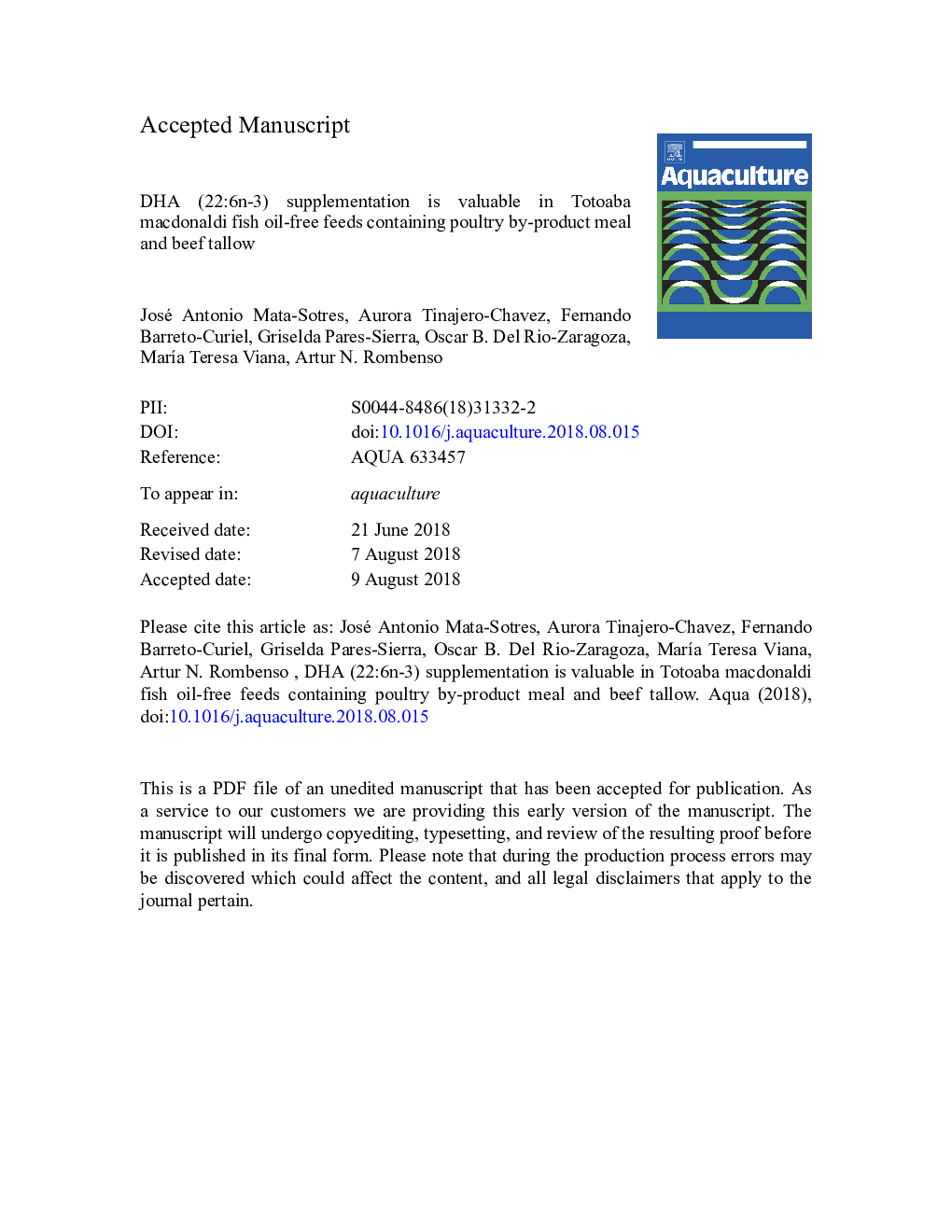| کد مقاله | کد نشریه | سال انتشار | مقاله انگلیسی | نسخه تمام متن |
|---|---|---|---|---|
| 8492927 | 1552791 | 2018 | 45 صفحه PDF | دانلود رایگان |
عنوان انگلیسی مقاله ISI
DHA (22:6n-3) supplementation is valuable in Totoaba macdonaldi fish oil-free feeds containing poultry by-product meal and beef tallow
دانلود مقاله + سفارش ترجمه
دانلود مقاله ISI انگلیسی
رایگان برای ایرانیان
کلمات کلیدی
موضوعات مرتبط
علوم زیستی و بیوفناوری
علوم کشاورزی و بیولوژیک
علوم آبزیان
پیش نمایش صفحه اول مقاله

چکیده انگلیسی
It was evaluated the effect of DHA (extract from Aurantiochytrium sp.) inclusion in diets formulated with poultry by-product meal (PBM) using beef tallow (TALLOW) to fulfill the lipid demand in substitution of fish oil (FO) in juvenile totoaba (9.5 ± 0.1â¯g). With this purpose four diets were formulated to contain PBM with FO (PBMâ¯+â¯FO positive control) or TALLOW (PBMâ¯+â¯TALLOW negative control) and two diets containing different levels of DHA; one supplemented with 50% (PBMâ¯+â¯TALLOW+50%DHA) and 100% DHA (PBMâ¯+â¯TALLOW+100%DHA), based on DHA requirements for marine carnivore fish. After nine weeks, no signs of fatty acid (FA) deficiency were noticed; survival was above 92% across dietary treatments, and production performance was also similar, with exception of feed conversion ratio and viscerosomatic index. Tissues proximate composition was affected by dietary treatments. Tallow-based diets increased hepatic lipid content. However, 100% DHA supplementation adjusted this effect. Overall blood parameters were not influenced by tallow inclusion, except for triglycerides. Fish fed the PBMâ¯+â¯TALLOW diet exhibited significant higher levels of triglycerides compared to those fed the PBMâ¯+â¯FO diets. However, the DHA supplementation in both levels amended this effect. The FA profile in the liver and muscle tissues were affected and reflected the dietary fatty acid composition to some extent. Tallow-based diets exhibited significantly higher levels of MUFAs (e.g., 18:1n-9) and reduced levels of SFAs than those fed the PBMâ¯+â¯FO control diet. Muscle tissue of fish fed the PBMâ¯+â¯TALLOW diet exhibited significantly lower levels of DHA and EPA than that fed PBMâ¯+â¯FO diet. However, DHA supplementation partially corrected this effect by enhancing DHA content in muscle. The magnitude of LC-PUFA “sparing effect” in the present study was limited due to the elevated levels of dietary 18:2n-6 from the PBM that accumulated in the muscle tissue in the extent of the LC-PUFAs. In summary, the current results provide valuable insights regarding dietary DHA in juvenile totoaba towards formulating fish oil-free diets. Dietary PBM and beef tallow successfully replaced FO in the context of production performance and overall blood parameters. DHA supplementation was beneficial for enhancing the levels of this human health-promoting fatty acid in the muscle tissue. Also, it might increase fish performance reducing the need of using fish oil in aquafeeds. We suggest that towards fish oil-free aquafeed formulations it is essential to balance the dietary fatty acids. Concomitant to this fact, it will be necessary to reduce the lipid content in PBM to facilitate feed formulation.
ناشر
Database: Elsevier - ScienceDirect (ساینس دایرکت)
Journal: Aquaculture - Volume 497, 1 December 2018, Pages 440-451
Journal: Aquaculture - Volume 497, 1 December 2018, Pages 440-451
نویسندگان
José Antonio Mata-Sotres, Aurora Tinajero-Chavez, Fernando Barreto-Curiel, Griselda Pares-Sierra, Oscar B. Del Rio-Zaragoza, MarÃa Teresa Viana, Artur N. Rombenso,